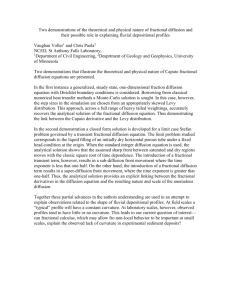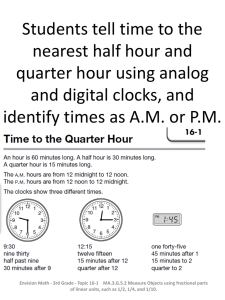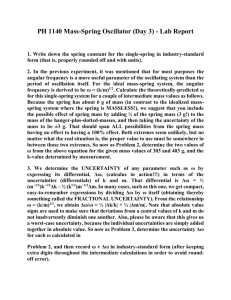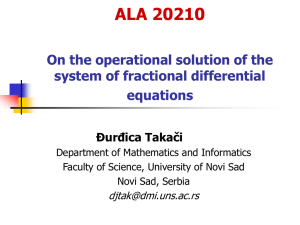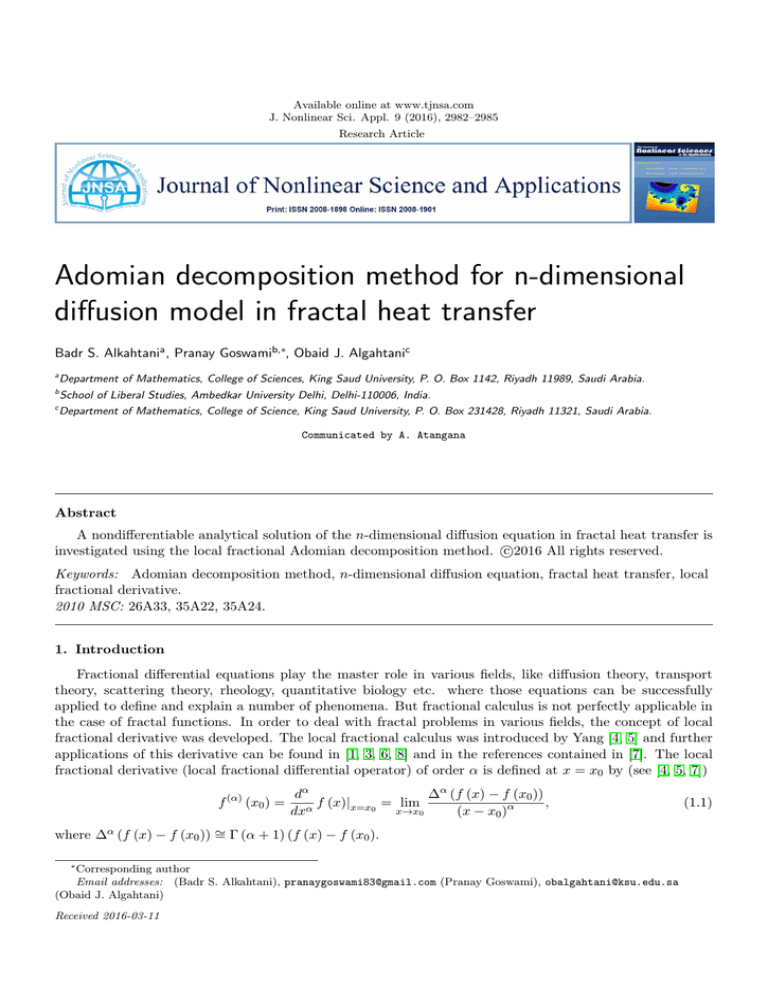
Available online at www.tjnsa.com
J. Nonlinear Sci. Appl. 9 (2016), 2982–2985
Research Article
Adomian decomposition method for n-dimensional
diffusion model in fractal heat transfer
Badr S. Alkahtania , Pranay Goswamib,∗, Obaid J. Algahtanic
a
Department of Mathematics, College of Sciences, King Saud University, P. O. Box 1142, Riyadh 11989, Saudi Arabia.
b
School of Liberal Studies, Ambedkar University Delhi, Delhi-110006, India.
c
Department of Mathematics, College of Science, King Saud University, P. O. Box 231428, Riyadh 11321, Saudi Arabia.
Communicated by A. Atangana
Abstract
A nondifferentiable analytical solution of the n-dimensional diffusion equation in fractal heat transfer is
c
investigated using the local fractional Adomian decomposition method. 2016
All rights reserved.
Keywords: Adomian decomposition method, n-dimensional diffusion equation, fractal heat transfer, local
fractional derivative.
2010 MSC: 26A33, 35A22, 35A24.
1. Introduction
Fractional differential equations play the master role in various fields, like diffusion theory, transport
theory, scattering theory, rheology, quantitative biology etc. where those equations can be successfully
applied to define and explain a number of phenomena. But fractional calculus is not perfectly applicable in
the case of fractal functions. In order to deal with fractal problems in various fields, the concept of local
fractional derivative was developed. The local fractional calculus was introduced by Yang [4, 5] and further
applications of this derivative can be found in [1, 3, 6, 8] and in the references contained in [7]. The local
fractional derivative (local fractional differential operator) of order α is defined at x = x0 by (see [4, 5, 7])
f (α) (x0 ) =
∆α (f (x) − f (x0 ))
dα
f
(x)|
=
lim
,
x=x0
x→x0
dxα
(x − x0 )α
where ∆α (f (x) − f (x0 )) ∼
= Γ (α + 1) (f (x) − f (x0 ).
∗
Corresponding author
Email addresses: (Badr S. Alkahtani), pranaygoswami83@gmail.com (Pranay Goswami), obalgahtani@ksu.edu.sa
(Obaid J. Algahtani)
Received 2016-03-11
(1.1)
B. S. Alkahtani, P. Goswami, O. J. Algahtani, J. Nonlinear Sci. Appl. 9 (2016), 2982–2985
2983
Let a = t0 < t1 < t2 < · · · < tN = b be a partition of [a, b], ∆tj = tj+1 − tj and ∆t = max{∆t0 , ∆t1 , . . . };
then local fractional integral of f (x) in the interval [a, b] is given by (see [4, 5, 7])
(α)
a Ib f
1
(x) =
Γ (1 + α)
Zb
N −1
X
1
lim
f (tj )(∆tj )α .
f (t) (dt) =
Γ (1 + α) ∆t→0
α
(1.2)
j=0
a
The n-D diffusion model in fractal heat transfer, involving local fractional derivatives (LFD) was presented
by
∂ α Φ (x, y, z, τ )
η α ∇2α Φ (x, y, z, τ ) =
,
(1.3)
∂τ α
subject to the initial and boundary conditions
Φ (x1 , x2 , . . . xn , 0) = f (x1 , x2 , . . . xn )
Φ (0, x2 , . . . xn , τ ) = Φ (a1 , x2 , . . . xn , , τ ) = g1 (x2 , . . . xn , τ )
Φ (x1 , 0, . . . xn , τ ) = Φ (x1 , a2 , . . . xn , , τ ) = g2 (x1 , . . . xn , τ )
..
.
(1.4)
Φ (x1 , x2 , . . . an , τ ) = Φ (x1 , x2 , . . . an , , τ ) = gn (x1 , . . . xn−1 , τ ) ,
where the local fractional n-dimensional Laplace operator, which is a generalization of local fractional
Laplace operator studied in [1]–[7], is defined by
∇
2α
n
X
∂ 2α
=
,
∂x2α
i
i=1
(1.5)
where η α is a nondifferentiable diffusion coefficient, and Φ(x1 , x2 , . . . , xn , τ ) is the nondifferentiable concentration distribution. Recently, the authors [8] suggested the local fractional Adomian decomposition
method (LFADM) to deal with 1-D diffusion equation on Cantor time-space. Yang et al. [6, 7] developed
nondifferential solution to wave equation on Cantor sets within the LFD. Further, 3-D diffusion equation was
considered by Fan et al. [2]. In this paper we implement local fractional Adomian decomposition method
(LFADM) on the n-D diffusion model in fractal heat transfer.
2. n-Dimensional diffusion model in fractal heat transfer
We first rewrite the problem (1.3) in the local fractional operator form:
"m
#
X
(α)
α
2α
Lt Φ = η
Lxi xi Φ ,
(2.1)
i=1
where the local fractional differential operator is defined by
Lx(2α)
(.) =
i xi
∂ 2α
(.),
∂x2i
L(α)
τ (.) =
∂α
(.), i = 1, 2, ..., m.
∂τ
Taking the inverse operator L−α
to both sides of (2.1) and using the initial condition leads to
τ
" n
#
X
(−α) (α)
(−α)
Lt Lt Φ = η α Lt
L(2α)
xi xi Φ .
(2.2)
(2.3)
i=1
Hence, we get
Φ(x1 , x2 , . . . , xn , τ ) =
(−α)
η α Lt
" n
X
i=1
#
L(2α)
xi xi Φ(x1 , x2 , . . . , xn , τ )
+ Φ(x1 , x2 , . . . , xn , 0).
(2.4)
B. S. Alkahtani, P. Goswami, O. J. Algahtani, J. Nonlinear Sci. Appl. 9 (2016), 2982–2985
2984
According to the LFADM we decompose the unknown function Φ(x1 , x2 , . . . , xn , τ ) in an infinite series
∞
X
Φ(x1 , x2 , . . . , xn , τ ) =
Φm (x1 , x2 , . . . , xn , τ ).
(2.5)
m=0
Substituting (2.5) into (2.4) yields
∞
X
"
Φm =
(−α)
η α Lt
n
X
m=0
∞
X
L(2α)
xi xi
!#
Φm
+ Φ(x1 , x2 , . . . , xn , 0).
(2.6)
m=0
i=1
The components Φm (x1 , x2 , . . . , xn , τ ), m ≥ 0 can be completely determined by
Φ0 (x1 , x2 , . . . , xn , τ ) = Φ(x1 , x2 , . . . , xn , 0)
" n
#
X
α (−α)
(2α)
Φm+1 (x1 , x2 , . . . , xn , τ ) = η Lt
Lxi xi Φm (x1 , x2 , . . . , xn , τ ) ,
m ≥ 0.
(2.7)
i=1
If we take the following initial and boundary conditions
Φ(x1 , x2 , . . . , xn , 0) =
n
Y
cosα (xαi )
i=1
n
Y
α
Φ(0, x2 , . . . , xn , τ ) = Φ(π, x2 , . . . , xn , τ ) = nEα (− (ητ ) )
Φ(x1 , 0, . . . , xn , τ ) = Φ(x1 , π, . . . , xn , τ ) = nEα (− (ητ )α )
cosα (xαi )
i=2,i6=1
n
Y
cosα (xαi )
(2.8)
i=1,i6=2
..
.
α
Φ(x1 , x2 , . . . , 0, τ ) = Φ(x1 , x2 , . . . , π, τ ) = nEα (− (ητ ) )
n−1
Y
cosα (xαi ),
i=1
then we get
Φ0 (x1 , x2 , . . . , xn , τ ) = Φ(x1 , x2 , . . . , xn , 0) =
n
Y
cosα (xαi )
(2.9)
i=1
"
Φm+1 (x1 , x2 , . . . , xn , τ ) =
(−α)
η α Lt
n
X
#
L(2α)
xi xi Φm (x1 , x2 , . . . , xn , τ )
m ≥ 0.
,
(2.10)
i=1
Puting m = 0 into equation (2.10), we obtain
Φ1 (x1 , x2 , . . . , xn , τ ) =
(−α)
η α Lt
=−
" n
X
#
L(2α)
xi xi Φ0 (x1 , x2 , . . . , xn , τ )
i=1
n
Y
n(ητ )α
Γ(1 + α)
(2.11)
cosα (xαi ),
i=1
#
" n
X
α (−α)
(2α)
Φ2 (x1 , x2 , . . . , xn , τ ) = η Lt
Lxi xi Φ1 (x1 , x2 , . . . , xn , τ )
=
n(ητ )2α
i=1
n
Y
Γ(1 + 2α)
i=1
(2.12)
cosα (xαi ),
B. S. Alkahtani, P. Goswami, O. J. Algahtani, J. Nonlinear Sci. Appl. 9 (2016), 2982–2985
" n
#
X
(−α)
Φ3 (x1 , x2 , . . . , xn , τ ) = η α Lt
L(2α)
xi xi Φ2 (x1 , x2 , . . . , xn , τ )
=−
i=1
n
3α
Y
n(ητ )
Γ(1 + 3α)
2985
(2.13)
cosα (xαi ),
i=1
and proceeding the same way, we get the following solution in the series form
Φ(x1 , x2 , . . . , xn , τ ) =
=
∞
X
m=0
∞
X
m=0
Φm (x1 , x2 , . . . , xn , τ )
n
n(ητ )α Y
cosα (xαi )
Γ(1 + mα)
= nEα [− (ητ )α ]
(2.14)
i=1
n
Y
cosα (xαi ).
i=1
3. Conclusion
We have successfully applied the LFADM to solve the n-dimensional diffusion model in fractal heat
transfer involving LFD. Analytical solutions of n-dimensional diffusion model on Cantor sets involving local
fractional derivatives are efficiently developed.
Acknowledgements
The authors would like to express their sincere appreciation to the Deanship of Scientific Research at
King Saud University for funding this research group, number RG-1437-17.
References
[1] B. S. Alkahtani, V. Gulati, P. Goswami, On the Solution of Generalized Space Time Fractional Telegraph Equation,
Math. Probl. Eng., 2015 (2015), 7 pages. 1, 1
[2] Z. P. Fan, H. K. Jassim, R. K. Raina, X.-J. Yang, Adomian Decomposition Method for Three Dimensional
Diffusion Model in Fractal Heat Transfer Involving Local Fractional Derivatives, Thermal Sci., 19 (2015), S137–
S141. 1
[3] P. Goswami, R. T. Alqahtani, On the Solution of Local Fractional Differential Equations Using Local Fractional
Laplace Variational Iteration Method, Math. Probl. Eng., 2016 (2016), 6 pages. 1
[4] X.-J. Yang, Local Fractional Functional Analysis and Its Applications, Asian Academic Publisher, Hong Kong,
(2011). 1, 1
[5] X.-J. Yang, Advanced Local Fractional Calculus and Its Applications, World Science Publisher, New York, (2012).
1, 1
[6] X.-J. Yang, D. Baleanu, P. Lazarević Mihailo, S. Cajić Milan, Fractal Boundary Value Problems for Integral and
Differential Equations with Local Fractional Operators, Thermal Sci., 19 (2015), 959–966. 1, 1
[7] X.-J. Yang, D. Baleanu, H. M. Srivastava, Local Fractional Integral Transforms and Their Applications, Academic
Press, Amesterdam, (2016). 1, 1, 1, 1
[8] X.-J. Yang, D. Baleanu, W.-P. Zhong, Approximate solutions for diffusion equations on Cantor space-time, Proc.
Romanian Acad. Ser. A Math. Phys. Tech. Sci. Inf. Sci., 14 (2013), 127–133. 1, 1


